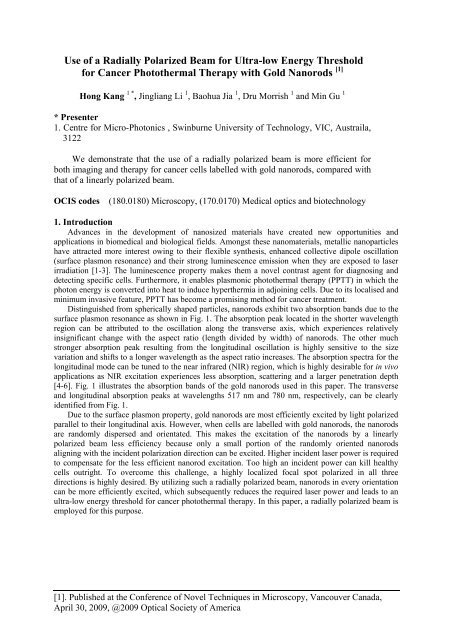Workshop proceeding - final.pdf - Faculty of Information and ...
Workshop proceeding - final.pdf - Faculty of Information and ...
Workshop proceeding - final.pdf - Faculty of Information and ...
Create successful ePaper yourself
Turn your PDF publications into a flip-book with our unique Google optimized e-Paper software.
Use <strong>of</strong> a Radially Polarized Beam for Ultra-low Energy Threshold<br />
for Cancer Photothermal Therapy with Gold Nanorods [1]<br />
Hong Kang 1 * , Jingliang Li 1 , Baohua Jia 1 , Dru Morrish 1 <strong>and</strong> Min Gu 1<br />
* Presenter<br />
1. Centre for Micro-Photonics , Swinburne University <strong>of</strong> Technology, VIC, Austraila,<br />
3122<br />
We demonstrate that the use <strong>of</strong> a radially polarized beam is more efficient for<br />
both imaging <strong>and</strong> therapy for cancer cells labelled with gold nanorods, compared with<br />
that <strong>of</strong> a linearly polarized beam.<br />
OCIS codes<br />
(180.0180) Microscopy, (170.0170) Medical optics <strong>and</strong> biotechnology<br />
1. Introduction<br />
Advances in the development <strong>of</strong> nanosized materials have created new opportunities <strong>and</strong><br />
applications in biomedical <strong>and</strong> biological fields. Amongst these nanomaterials, metallic nanoparticles<br />
have attracted more interest owing to their flexible synthesis, enhanced collective dipole oscillation<br />
(surface plasmon resonance) <strong>and</strong> their strong luminescence emission when they are exposed to laser<br />
irradiation [1-3]. The luminescence property makes them a novel contrast agent for diagnosing <strong>and</strong><br />
detecting specific cells. Furthermore, it enables plasmonic photothermal therapy (PPTT) in which the<br />
photon energy is converted into heat to induce hyperthermia in adjoining cells. Due to its localised <strong>and</strong><br />
minimum invasive feature, PPTT has become a promising method for cancer treatment.<br />
Distinguished from spherically shaped particles, nanorods exhibit two absorption b<strong>and</strong>s due to the<br />
surface plasmon resonance as shown in Fig. 1. The absorption peak located in the shorter wavelength<br />
region can be attributed to the oscillation along the transverse axis, which experiences relatively<br />
insignificant change with the aspect ratio (length divided by width) <strong>of</strong> nanorods. The other much<br />
stronger absorption peak resulting from the longitudinal oscillation is highly sensitive to the size<br />
variation <strong>and</strong> shifts to a longer wavelength as the aspect ratio increases. The absorption spectra for the<br />
longitudinal mode can be tuned to the near infrared (NIR) region, which is highly desirable for in vivo<br />
applications as NIR excitation experiences less absorption, scattering <strong>and</strong> a larger penetration depth<br />
[4-6]. Fig. 1 illustrates the absorption b<strong>and</strong>s <strong>of</strong> the gold nanorods used in this paper. The transverse<br />
<strong>and</strong> longitudinal absorption peaks at wavelengths 517 nm <strong>and</strong> 780 nm, respectively, can be clearly<br />
identified from Fig. 1.<br />
Due to the surface plasmon property, gold nanorods are most efficiently excited by light polarized<br />
parallel to their longitudinal axis. However, when cells are labelled with gold nanorods, the nanorods<br />
are r<strong>and</strong>omly dispersed <strong>and</strong> orientated. This makes the excitation <strong>of</strong> the nanorods by a linearly<br />
polarized beam less efficiency because only a small portion <strong>of</strong> the r<strong>and</strong>omly oriented nanorods<br />
aligning with the incident polarization direction can be excited. Higher incident laser power is required<br />
to compensate for the less efficient nanorod excitation. Too high an incident power can kill healthy<br />
cells outright. To overcome this challenge, a highly localized focal spot polarized in all three<br />
directions is highly desired. By utilizing such a radially polarized beam, nanorods in every orientation<br />
can be more efficiently excited, which subsequently reduces the required laser power <strong>and</strong> leads to an<br />
ultra-low energy threshold for cancer photothermal therapy. In this paper, a radially polarized beam is<br />
employed for this purpose.<br />
[1]. Published at the Conference <strong>of</strong> Novel Techniques in Microscopy, Vancouver Canada,<br />
April 30, 2009, @2009 Optical Society <strong>of</strong> America
















